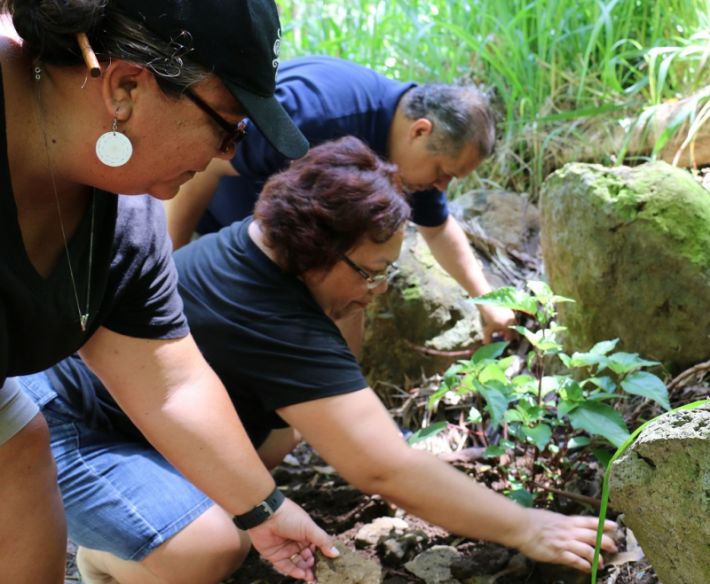The last time the māhealani or full moon coincided with the summer solstice was in 1948. This phenomenon happens about once every 70 years. The māhealani moon is known as the most excellent day of the month for planting and fishing. With the days directly following being best for planting trees and perennial crops that require strong root systems. In modern application, this perspective also represents setting foundations or planning and preparation for the upcoming year.
The word solstice is derived from Latin, meaning “sun to stand still” and refers to how the sun’s relative position in the sky at noon seems to “stand still” during the solstice and the days that surround it. When the sun is at its highest point in the sky, casting no shadow, it is said that this is the time of greatest personal mana (divine power) and when man is in most alignment with the universe.
Guided by cultural principles and practices Kamehameha Schools Community Engagement and Resources (CE&R) leaders from across the pae ʻāina (island chain) recently gathered for the summer solstice on Hawaiʻi island to secure their mana as they discussed plans for the work ahead.
The trip started at sunrise at Moku Ola in Hilo on the east side of Hawaii island. There, staff greeted the rising solstice sun with oli (chants) as the māhealani moon set over Mauna Loa, and participated in traditional kapu kai – immersing themselves in the ocean to purify and ward off negative energies.
Following the path of the sun, the group traveled across the island stopping to visit with community partners like HuiMAU in Hāmākua – a non-profit organization focusing on ʻāina- and culture-based educational initiatives; particularly on reconnecting learners to ancestral knowledge of place and enacting kuleana through place-specific practices of mālama ʻāina.
The group also visited historical sites at Pu'ukoholā Heiau in Kawaihae. The heiau was built by Kamehameha I to secure his mana or spiritual power to help in unifying the Hawaiian people. It is said that the rocks used to build the heiau were carried from Pololū Valley, over Kohala Mountain, along a human chain that stretched nearly 25 miles.
Next, in the ahupuaʻa of Keahuolū in Kona, the Queen Liliʻuokalani Trust’s Kepoʻokalani Interpretive Center provided an entryway to a 25-acre Historic Preserve, containing key elements of a traditional agricultural complex known as the “Kona Field System,” a sophisticated system that not only sustained the lives of ancient Hawaiians but enabled them to thrive.
The day ended at sunset upon Hāpaialiʻi Heiau in Kahaluʻu Ma Kai on the west side of the island. Stone pillars on Hāpaialiʻi Heiau mark the summer and winter solstices as well as the fall and spring equinoxes. Together, with local cultural practitioners, CE&R staff honored the celestial event with traditional oli and pīkai ceremony – sprinkling of salt or sea water to purify and protect.
“This huakaʻi (field trip) was a great way for us to reconnect to the ways our kūpuna knew things, understanding the elements and ʻāina that spiritually sustain our communities,” said Kilohana Hirano, CE&R regional director for East Hawaiʻi.
“Throughout the day, there were many hōʻailona (signs) affirming our activities and visits to different wahi pana and wahi kūpuna (sacred sites) as we strive toward a thriving lāhui through aloha ʻāina and hoʻōla lāhui. At the end of the day it was really experiencing the ʻōlelo noʻeau ‘O Hawaiʻi kuʻu kulāiwi.’”
Ancestral perspectives of land stewardship are universal, inspiring a sense of collective responsibility that begins with this island home and extends to the larger planet. “ʻO Hawaiʻi kuʻu kulāiwi” speaks to devotion to the native homeland, Hawaiʻi as expressed through acts of aloha ʻāina – Hawaiian patriotism, and engagement of learners of all ages in experiences that foster love for and life-long allegiance to our Hawaiian homeland and lāhui Hawaiʻi.
KS believes that its mission can be most effectively realized by a workforce and a student body that are committed to hoʻōla lāhui or revitalization of the Hawaiian people. Shared customs, values and behaviors strengthen KS' identity as a Native Hawaiian organization and its commitment to fostering environments that value relationships and unite learners in traditions, practices, and behaviors while respecting diversity of cultural expression.
To better serve the lāhui, CE&R is building and strengthening relationships to gain a better understanding of KS, its resources and the strengths and challenges of Native Hawaiian communities. Through CE&R, KS is working to connect its educational services, lands, and the resources of each community holistically to improve the wellbeing of people and place, region-by-region.

On their journey across the island, CE&R leaders helped mālama ʻāina o Pauahi in Hāmākua. Above are: Regional Director, Kalei Kaʻilihiwa, Sr. Manager, Bobbie Tom, and Sr. Director Hawaiʻi island, Alapaki Nahale-a.

The group also met with community partners like Noʻeau Peralto with HuiMAU (right). Left: Director of ʻĀina Engagement Brandi Beaudet.

Paʻakai (salt) is placed atop the head as part of the protocol for the ceremony.

Wai (water) was collected from the different Hawaiʻi island moku or districts for the ceremony.

The wai was carried to the upright stone that marks the location the sun sets during the summer solstice on Hāpaialiʻi Heiau.
TAGS
community engagement and resources,
ce&r,
facultystaff
CATEGORIES
Kaipuolono Article, Newsroom, Department News, Features
Print with photos
Print text only










